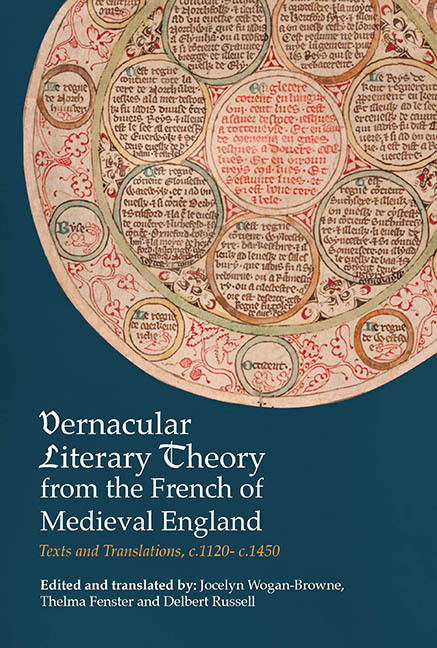 Vernacular Literary Theory from the French of Medieval England
Vernacular Literary Theory from the French of Medieval England Book contents
- Frontmatter
- Dedication
- Contents
- List of Maps and Illustrations
- Preface
- Abbreviations
- Map
- General Introduction
- Establishment of Texts and Translations and Conventions Used
- Part I Faus franceis and dreit engleis: On Language
- Part II Si sa dame ne li aidast: Authorship and the Patron
- Part III Primes dirrum la dreyte fei: The Conduct of Reading, Hearing and Seeing
- Part IV Ki veult oïr: Forming Audiences and Creating Textual Communities
- Part V Si come en latyn trovay escrit: The Lineage of the Text
- Postlude. Honneurs publiées … en divers royaumes
- Part VI Essays and Resources
- Timeline
- Glossary
- Bibliography
- General Index
- Index of Manuscripts
Part IV - Ki veult oïr: Forming Audiences and Creating Textual Communities
Published online by Cambridge University Press: 25 October 2017
- Frontmatter
- Dedication
- Contents
- List of Maps and Illustrations
- Preface
- Abbreviations
- Map
- General Introduction
- Establishment of Texts and Translations and Conventions Used
- Part I Faus franceis and dreit engleis: On Language
- Part II Si sa dame ne li aidast: Authorship and the Patron
- Part III Primes dirrum la dreyte fei: The Conduct of Reading, Hearing and Seeing
- Part IV Ki veult oïr: Forming Audiences and Creating Textual Communities
- Part V Si come en latyn trovay escrit: The Lineage of the Text
- Postlude. Honneurs publiées … en divers royaumes
- Part VI Essays and Resources
- Timeline
- Glossary
- Bibliography
- General Index
- Index of Manuscripts
Summary
Introduction
The needs and responses of inscribed audiences are a frequent rationale for textual composition. Most vernacular works share a conceptualisation of audience-text relations as a face-to-face encounter with the people for whom a text is initially written, whether or not those specific relations were ever actualised or are pertinent to the version of the text in hand. Historical audiences are linked to but do not necessarily remain the same as production communities or textually inscribed communities. Nor are they defined by them as a single hypostasised community of one language or a particular social status. The audience for the ‘Londonisation’ of Brunetto Latini in the Liber custumarum (8a), for instance, probably identified itself not as a francophone community but as members of the occupational sub-groups of a highly variegated civic public: the court, plurilingual administrators, bureaucrats, merchants, urban dwellers of various kinds. So too the Crabhouse nunnery register (36), more concerned with verse and prose distinctions than its own trilinguality, testifies to the mixed and fluid socio-linguistics of female houses, witnessed in the linguistic ranges of their devotional, doctrinal, and administrative texts, and in their ecclesiastical and lay patronage networks.
Part IV's most explicit meditation on audiences and their formation as textual communities is Denis Piramus's prologue to his life of Edmund of East Anglia (27). As Ian Short has shown, this prologue offers considerable thought about vernacular writing (well worth consideration alongside more frequently discussed prologues such as those of Chrétien de Troyes or Marie de France).1 Piramus's prologue plays with the assignation of literary genre to specific class or occupational groups and then transforms, redirects and complicates such correspondences together with the whole question of whether texts are to offer sentence or solace to their audiences. Wace's late-twelfth-century Vie de saint Nicolas (25a) adapts estates theory to form a cult community of audience and narrator. The anonymous thirteenth-century Vie de seint Clement (25b) outlines with mocking wit the usual parameters of academic writing and its ambitions in order to create narration and audience as joined in a textual community pursuing more useful and less well-known material and readings. A stylish piece of niche marketing, this prologue sets up a pace and intimacy sufficient to sustain with brio the succeeding 15,000 line vernacularisation of the Clementine Recognitions.
- Type
- Chapter
- Information
- Vernacular Literary Theory from the French of Medieval EnglandTexts and Translations, c.1120- c.1450, pp. 249 - 340Publisher: Boydell & BrewerPrint publication year: 2016


